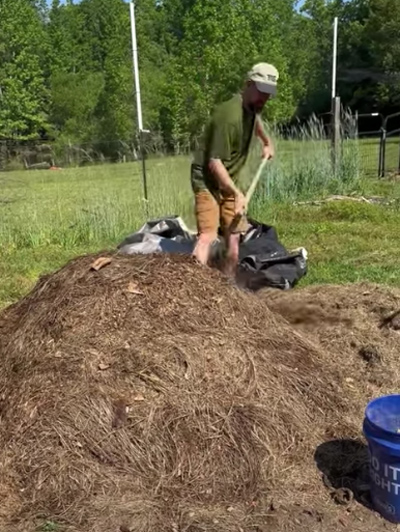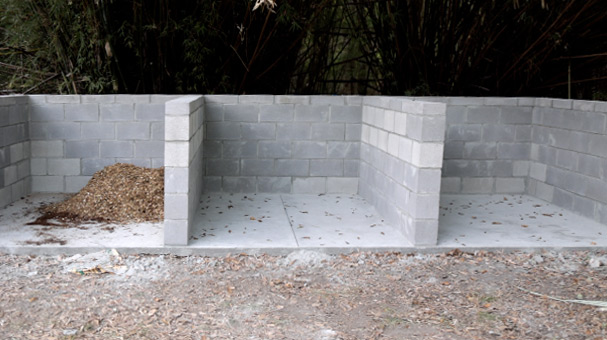There is a misconception that a compost pile must be made directly on the ground.
Though we have done that many times, we have also composted in barrels, in large enclosed bins, in an old refrigerator, and on concrete slabs.
In our latest video I explain why composting in a pile with a bottom on it is just fine:
The main issue with composting directly on the ground is the power of tree roots. If you are anywhere near a tree, it will happily fill your pile with roots.
From the Comments
Chet writes: “We had our first compost bin under a very large maple tree in our chicken run. I think it was there for maybe a year and a half and then transitioned to keeping one nearer the garden. Now 2 1/2 years later you can still see where it was because of the mound of maple tree roots that grew up into it”
And Jeanna writes: “I found this out the hard way. It was AMAZING how happy those tree roots were….”
SS writes: “True true. I composted near bamboo. The roots grew up in it. Probably sucked everything out of it to. Great explaining this system. I suppose a cheaper would be laying roof tin down.”
zmblion writes: “I agree with you ive had my compost 100ft or more from the nearest tree and have found roots all in it. When i rebuild mine i will at least line it with brick or block or something. I’ve found worms in a gutter that wasn’t cleaned for years. I think this is a great system”
internetcomposting writes: “I remember cleaning out someone’s gutters of 10+ years of neglect & I managed to get 6 full garbage bags of the stuff & had the hubby haul it back down to our place, hours away, to put in our compost pile. The stuff was absolutely amazing.”
ganggreen writes: “Not a compost bin, but a similar issue. I have a medium size back yard with a very large maple tree right in the center. A few years ago I put in three raised bed gardens, by this spring they were totally root bound by the tree.”
gelwood writes: “Yes, roots will always find a way to take over the compost. Even with a tractor after a few months, we went to turn it and it was impenetrable! We took down the sides and let nature have its way! This was exactly what I needed to see because I was thinking of putting down a sheet of steel roofing to stop it but I now don’t think even that would work.!”
k.p. writes: “I actually DO have room for a smaller version of your compost area. I stopped composting because of the tree issue. There is nothing more aggravating than building a pile for over a year, to finally be ready to use it, and to find the spider web of millions of tree roots. Even worse, to find they had sucked every scrap of nutrition out of the pile, and basically you have 5 CY’s of fill. 😏😏 OH, and then the Johnson grass that took over another pile. Chopped and chopped and chopped and that stuff got a SUPER charge to spread throughout my yard.”
sixheadedgoblin notes: “I buried cinder blocks underneath my compost bins because of roots. Not tree roots – that part of my property has a ton of bind weed. Six years in with those bins now and I’ve yet to have any real trouble with the bind weed getting into my compost. There’s been a weak vine here and there that likely came from seed, but no intrusion of the roots into the pile. There are definitely reasons to exclude the wider soil from your compost pile.”
The arguments against compost piles with bottoms
The argument against compost piles having bottoms on them is generally “but the worms won’t be able to get in!,” with occasional other objections about the soil bacteria and fungi being excluded.
However, we have seen worms climb walls, so that’s really not a worry. I have worms living in potted plants that are sitting on plastic weed barrier. They get in if they want to.
As Dan writes: “I have found worms in my gutters and wondered how the worm knew to climb up there?”
As for soil life, bacteria and fungi, that’s not an issue either. There is plenty of soil that gets mixed in with these piles, inoculating them well. And even if there wasn’t, the fungi and bacteria would still find them. Bread breaks out in multi-colored patches of mold on your counter without you inoculating it with anything, and despite it not sitting on the soil… don’t you think compost will be colonized similarly?
You’re fine composting on an impermeable surface. You’ll get compost.
However, you don’t need to do so. We have often composted on top of future garden areas so the extra nutrients go into the soil where next year’s crops will grow. We’ve also made plenty of piles right on the ground.

The important thing is to compost and avoid throwing good organic material in a landfill.
Our giant three-bin system was created to handle tons of waste which can then be broken down into a fine compost we can use in our plant nursery. You might not need to do anything on that grand a scale, but the principles of composting are the same.
Throw things on the ground (or on a slab or whatever) and they rot.
* * *
Today’s music:


3 comments
I think the only thing missed here was that a solid bottom can prevent good drainage meaning the compost will tend towards anaerobic rather than aerobic decomposition. This is not necessarily a bad thing, but it can get smelly and on a large scale and any run of can become a
biological pollutant.
Thinking there is a right or wrong here is probably a mistake. It all depends what you are looking for.
A small compost directly on the ground can be considered the equivalent of a large worm tower improving the soil wherever you placed it. The advantage being you can move it to wherever you think the garden can benefit from the extra fertility. In contrast a larger silo style compost with a solid base might be best if treated as a wormery, made to include some method of capturing, buffering or absorbing any run off if problems occur.
I believe this is why large scale operations set their compost up in wind rows and regular turn and churn the piles. Not only does this speed up the composting process, but reduces moisture levels and aerates the mix leading to a more consistent product.
Really amazing content David and family. Thank you for all of your information. I live on 0.28 acres in the suburbs, and am CONSTANTLY experimenting with making my own compost, the most recent being getting wood chips for free and using that as a base for my compost pile (for harvest Spring 2024) at the edge of my property, which is under a semi forest. There are roots everywhere. This past spring 2023 I did harvest about 10-12 wheelbarrows full of organic material to transfer to my 3 raised beds (35 feet long each) from that area. I am waiting until late Winter/early Spring 2024 to make a scientific determination if the wood chips helped (I did add a few wheelbarrow loads contribution to about 4 fruit trees I have in the space).
Happy Thanksgiving! That was a nice read while eating leftover harvest lasagna made with chaya,Seminole pumpkin and herbs from the garden.
I wore my compost your enemy shirt when I was going to nursery’s yesterday. The next time I feel like I need some attention that’s what i’m gonna do! Everyone notices it.
Comments are closed.